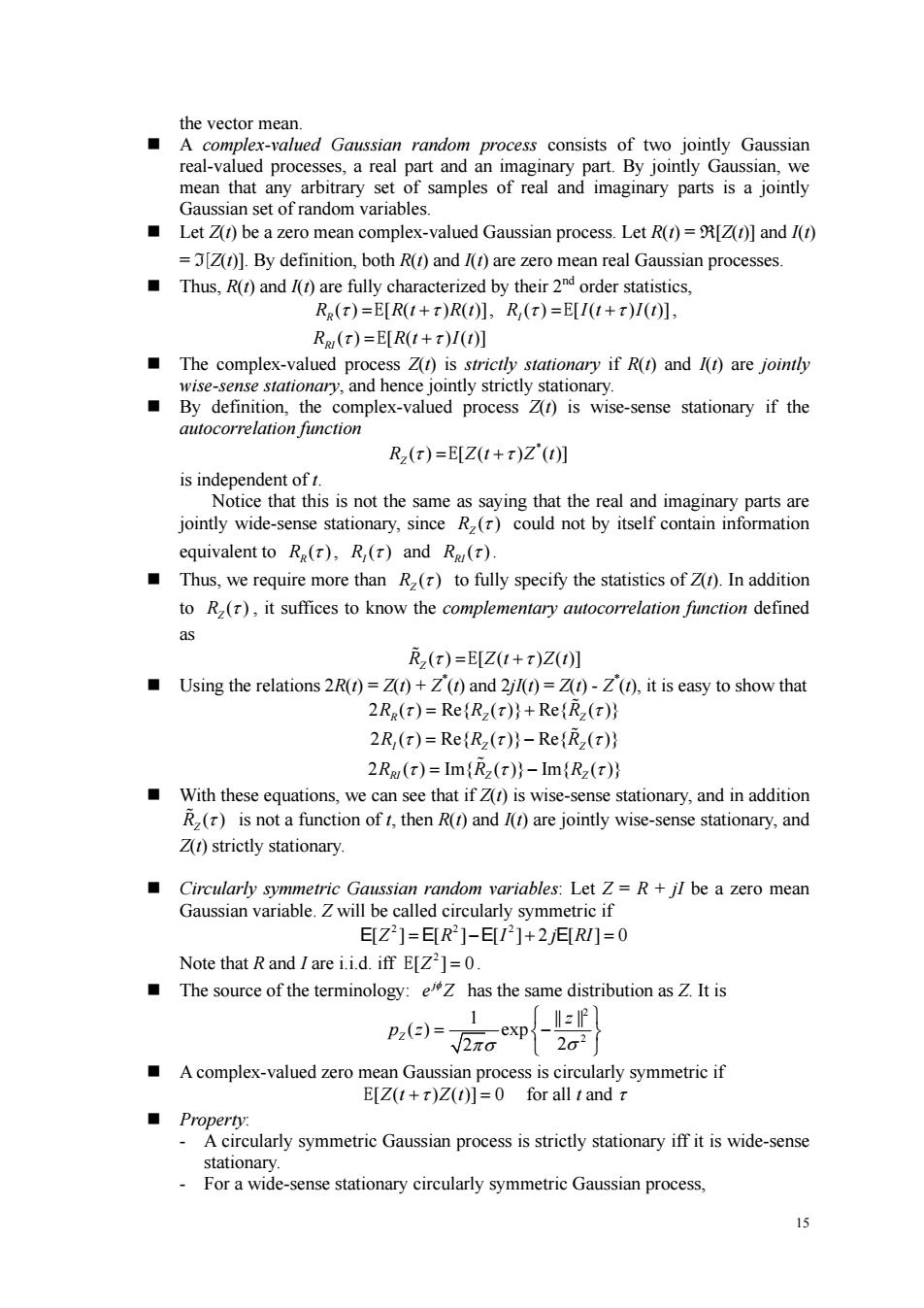正在加载图片...

the vector mean. A complex-valued Gaussian random process consists of two jointly Gaussian real-valued processes,a real part and an imaginary part.By jointly Gaussian,we mean that any arbitrary set of samples of real and imaginary parts is a jointly Gaussian set of random variables. Let Z(r)be a zero mean complex-valued Gaussian process.Let R(1)=[Z()]and /( By definition,both )and()arer mean real Gaussian Thus,R()and I()are fully characterized by their 2 order statistics. Rx()=E[R(t+)R(t)].R,()=E[I(t+)/()]. Ru(x)=E可R(t+x)l(] The complex-valued process)is strictly stationary if R(t)and I()are jointly se stanonary.and nenc ■By defin ,th tion functio R2()=EZ(+7)Z( is independent of t. Notice that this is not the same as saying that the real and imaginary parts are jointly wide-sense stationary,since R(r)could not by itself contain information equivalent to Ra(r).R(r)and Rg(r). Thus,we require more than R()to fully specify the statistics of Z().In addition to R(),it suffices to know the complementary autocorrelation function defined as R()=EIZ(+)Z(1)] Using the relations 2R(r)=Z(r)+Z(t)and 2jl()=Z()-Z(1).it is easy to show that 2Rg(r)=Re(R2(r))+Re(Rz(r)} 2R,(r)=Re(R2(r))-Re(R(r)} 2Rg(r)=Im(Rz())-Im(Rz(r) With these equations,we can see that if()is wise-sense stationary,and in addition R,(r)is not a function of t.then R(t)and /(t)are jointly wise-sense stationary.and Z(t)strictly stationary. Circularly symmetric Gaussian random variables:Let Z=R+jl be a zero mean Gaussian variable.Z will be called circularly symmetric if EIZ1=EIR1-EL1+2ER/I=0 Note that R and are i.i.d.iff E[Z2]=0. The source of the terminology:e has the same distribution as Z.It is paop} A complex-valued zero mean Gau s circularly symmetric if for all t and Property: A circularly symmetric Gaussian process is strictly stationary iff it is wide-sense aw -sense stationary circularly symmetric Gaussian process. 15 15 the vector mean. A complex-valued Gaussian random process consists of two jointly Gaussian real-valued processes, a real part and an imaginary part. By jointly Gaussian, we mean that any arbitrary set of samples of real and imaginary parts is a jointly Gaussian set of random variables. Let Z(t) be a zero mean complex-valued Gaussian process. Let R(t) = R[Z(t)] and I(t) = I[Z(t)]. By definition, both R(t) and I(t) are zero mean real Gaussian processes. Thus, R(t) and I(t) are fully characterized by their 2nd order statistics, ( ) [ ( ) ( )] RR τ = + E Rt Rt τ , ( ) [ ( ) ( )] RI τ =E It It +τ , ( ) [ ( ) ( )] RRI τ = + E Rt It τ The complex-valued process Z(t) is strictly stationary if R(t) and I(t) are jointly wise-sense stationary, and hence jointly strictly stationary. By definition, the complex-valued process Z(t) is wise-sense stationary if the autocorrelation function * ( ) [ ( ) ( )] RZ τ τ = + E Zt Z t is independent of t. Notice that this is not the same as saying that the real and imaginary parts are jointly wide-sense stationary, since ( ) RZ τ could not by itself contain information equivalent to ( ) RR τ , ( ) RI τ and ( ) RRI τ . Thus, we require more than ( ) RZ τ to fully specify the statistics of Z(t). In addition to ( ) RZ τ , it suffices to know the complementary autocorrelation function defined as ( ) [ ( ) ( )] RZ τ τ = + Zt Zt E Using the relations 2R(t) = Z(t) + Z* (t) and 2jI(t) = Z(t) - Z* (t), it is easy to show that 2 ( ) Re{ ( )} Re{ ( )} RR R RZ Z τ = + τ τ 2 ( ) Re{ ( )} Re{ ( )} RR R IZ Z τ = − τ τ 2 ( ) Im{ ( )} Im{ ( )} RRR RI Z Z τ = − τ τ With these equations, we can see that if Z(t) is wise-sense stationary, and in addition ( ) RZ τ is not a function of t, then R(t) and I(t) are jointly wise-sense stationary, and Z(t) strictly stationary. Circularly symmetric Gaussian random variables: Let Z = R + jI be a zero mean Gaussian variable. Z will be called circularly symmetric if 2 22 E EE E [ ] [ ] []2 [ ]0 Z R I j RI = −+ = Note that R and I are i.i.d. iff 2 E[ ]0 Z = . The source of the terminology: j e Zφ has the same distribution as Z. It is 2 2 1 || || ( ) exp 2 2 Z z p z πσ σ ⎧ ⎫ = −⎨ ⎬ ⎩ ⎭ A complex-valued zero mean Gaussian process is circularly symmetric if E[ ( ) ( )] 0 Zt Zt +τ = for all t and τ Property: - A circularly symmetric Gaussian process is strictly stationary iff it is wide-sense stationary. - For a wide-sense stationary circularly symmetric Gaussian process